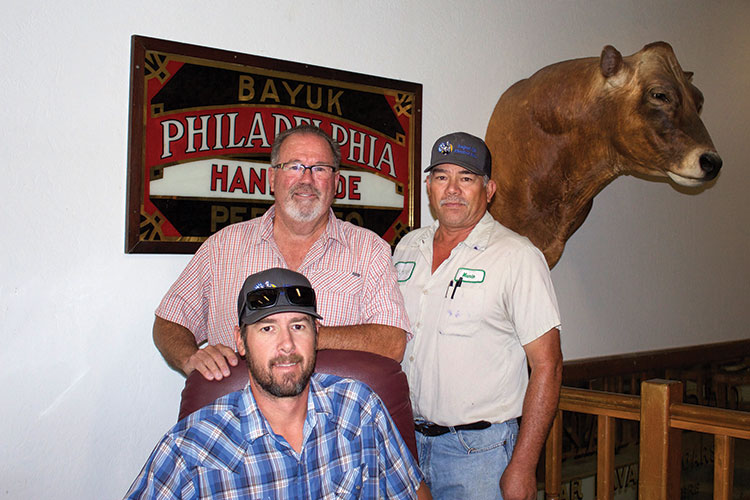
“Every fresh cow is enrolled in an aggressive postpartum program, including in-depth 12-day rectal temperature tracking,” said Gary de Graaff, a Platinum winner of the Dairy Cattle Reproduction Council’s tenth annual awards competition. “We also place emphasis on each cow having an ideal body condition score (BCS) entering the dry period along with an aggressive nutrition management, emphasizing quality forage,” said his son Daniel de Graaf, Pixley, Calif., who operates Jer-Z-Boyz Ranch with his father.
All six of this year’s Platinum winners of the Dairy Cattle Reproduction Council’s awards share additional insight in this Hoard’s Dairyman Intel as well as the Round Table found on pages 695 to 697 of the November issue of Hoard’s Dairyman. This year’s competition drew the second-largest set of nominations to date from 16 U.S. states, Canada, and Italy.
Here are additional responses to the question, “How do you manage fresh cows?”
Emerald Spring Dairy, Plainview, Minn.: We employ two-group dry cow housing for far-off and close-up cows. Heifers and cows also are separated postfreshening to more effectively manage social order.
Plymouth Dairy, LeMars, Iowa: Both cows and heifers are moved into a fresh pen together the day they calve. Heifers are moved to a first-lactation pen between two and four days in milk (DIM) and typically stay in that same pen until they are pregnant.
Meanwhile, cows are given a calcium bolus at calving and then 24 hours later are given a second calcium bolus. Cows are kept in the fresh pen until 12 to 15 DIM, and then moved to a multiparous pen until they are pregnant.
Both cows and heifers are closely monitored for 10 days postfresh by the herdsmen. Each day, fresh cows are evaluated and receive a green chalk mark on their hips by a herdsman if okay until they have 10 green marks (five on each hip). Then each cow gets its tailhead painted blue with paint.
The fresh pen, along with three other pens of high-producing, low DIM cows, are fed our high-milk-cow ration along with 1/3 pound of wheat straw and liquid Glucoboost. Our head herdsman, and only him, does a body condition score starting at 28 to 35 days precalving, 30 DIM, and at dry-off. Our head herdsman does the scoring to keep it consistent. He records each score and shares this information with our nutritionist.
Rollin Green Dairy, Brooklyn, Wis.: The smoother a transition period, the better cows will breed back. We try our best to never overcrowd the prefresh or fresh groups. Every cow gets Inforce 3, and cows 3-years-old or older also get sustained release calcium boluses at calving. There has been a significant improvement in fresh cow health overall since implementing the Inforce protocol.
We also blood sample every cow at five DIM to check blood ketone levels to make sure there is no subclinical ketosis or anything holding the cow back. We have found that if there are higher BHBA (beta-hydroxybutyrate) levels at freshening, it is an early indicator of illness or metabolic problems soon to come. We utilize the milk temperature feature on our milking units to catch fevers on our cows sooner then we would have by just observing for illness. We use a strong vaccination schedule staggered throughout different times of the year based on when we are already handling the cow.
We will not keep a cow for a long dry period anymore. It has to be an awfully exceptional cow to stand dry for more than 80 days. We cull harder than in the past if cows aren’t bred back timely. By not allowing cows to get overconditioned in the dry pen, there is definitely a smoother transition. Fat cows are an accident waiting to happen. All cow pens are walked three times a day to observe for illness
Schilling Farms, Darlington, Wis.: Fresh cows are monitored for the first 20 days after calving in the lockups each morning. Temperature, attitude, and appetite are closely watched for signs of illness. Early detection and treatment are key in preventing serious fresh cow disease and uterine infections, which may influence our conception rates.
All fresh cows are pumped with a fresh cow drench mix, which includes calcium propionate, alfalfa meal, and probiotics. All cows are checked at 5 and 11 days in milk for BHBA with a PortaCheck BHB meter. Cows are treated for ketosis, if needed.
Prostaglandin (Lutalyse) is given at 10 and 21 DIM to help with uterine involution. Cows are vaccinated with Bovi-Shield Gold 5 L5 HB on Day 21 to maximize immunity to reproductive diseases prior to breeding.
Nonesterified fatty acids (NEFAs) are periodically monitored in the prefresh group to assess body condition loss before calving. If NEFAs are high, rations are checked and adjusted accordingly.
DMIs (dry matter intakes) are monitored with FeedWatch daily in order to make sure that we are maximizing our feed intakes in the prefresh and postfresh groups.
Weisenbeck Dairy, Durand, Wis.: We prepare our prefresh cows well for the challenges postcalving. We try not to overcrowd the prefresh group by anymore than 5 percent.
This Hoard’s Dairyman Intel article is part of a nine-part series detailing top reproduction tips from the Platinum winning herds for the tenth annual Dairy Cattle Reproduction Council awards competition.








